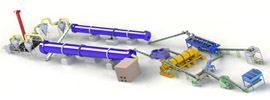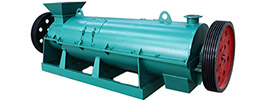Mushroom residue, the spent substrate after edible mushroom cultivation, is rich in organic matter, minerals, and beneficial microbial metabolites, making it an excellent raw material for organic fertilizer production. Through scientific processing, mushroom residue can be transformed into high-efficiency organic fertilizer, enhancing soil fertility and improving crop quality. Below are detailed steps and key considerations for this process:
I. Raw Material Preparation and Pretreatment
- Collection of Mushroom Residue
- Ensure the residue is free from mold, heavy metal contamination, and pesticide residues. Avoid using substrates from chemically treated mushroom cultivation.
- Categorization: Different mushroom species (e.g., oyster mushrooms, shiitake, enoki) may have varying substrate compositions; blending them can balance nutrient content.
- Moisture Adjustment
- Mushroom residue typically has 60–70% moisture content, which should be reduced to 50–60% (moist enough to form a ball when squeezed but crumble upon release) to facilitate fermentation.
- Adjustment Methods: Add dry straw, rice husks, or sawdust if moisture is too high; spray water if too low.
- Crushing and Mixing
- Crush the residue into particles smaller than 5 cm to improve aeration.
- Blending Auxiliary Materials: Combine with carbon-rich materials (e.g., straw, sawdust) and nitrogen-rich materials (e.g., livestock manure, soybean meal) to achieve a carbon-to-nitrogen (C/N) ratio of 25:1–30:1, promoting microbial decomposition.
II. Fermentation Process (Critical step)
- Inoculation with Fermentation Agents
- Use professional organic fertilizer starters (e.g., EM bacteria, Bacillus subtilis) as per instructions, evenly distributing them throughout the residue.
- Nitrogen Supplementation: Add a small amount of urea (0.5–1%) if nitrogen levels are insufficient to accelerate fermentation.
- Pile Construction and Management
- Pile Specifications: Build a stack 1.5–2 m wide, 1–1.5 m high, and any length. Line the base with 10 cm of straw for aeration.
- Insulation: Cover with plastic film or straw mats to maintain internal temperatures of 50–65°C.
- Turning Schedule: Aerate every 3–5 days by turning the pile to ensure uniform oxygen supply and temperature distribution. Fermentation completes in 15–30 days when temperatures drop to ambient levels, the material turns dark brown, and odors dissipate.
- Secondary Maturation (Optional)
- After primary fermentation, form smaller piles for an additional 1–2 months of maturation to further stabilize nutrients and reduce harmful substances.
III. Post-Fermentation Processing and Shaping
- Crushing and Screening
- Pulverize the matured material into a fine powder and screen out large particles or impurities.
- Functional Additives (Optional)
- Enhance fertilizer efficacy by incorporating micronutrients (e.g., boron, zinc), beneficial microbes (e.g., nitrogen-fixing bacteria, phosphate-solubilizing bacteria), or humic acid.
- Granulation and Drying
- Use a granulator to shape the powder into pellets for easier storage and application.
- Drying: Air-dry naturally or use low-temperature drying (≤60°C) to avoid nutrient degradation.
IV. Quality Testing and Storage
- Key Indicators
- Organic matter content ≥30%, total nutrients (N+P₂O₅+K₂O) ≥4%, moisture ≤20%, pH 5.5–8.5.
- Ensure absence of pathogens, insect eggs, and heavy metal contamination.
- Packaging and Storage
- Use breathable woven bags for packaging and store in a dry, ventilated area away from direct sunlight and rain.
V. Key Considerations
- Safety Precautions
- Fermentation generates high temperatures (up to 70°C); wear gloves and masks to avoid burns or inhalation of harmful gases.
- Environmental Compliance
- Locate fermentation sites away from residential areas to minimize odor nuisance. Add odor absorbents (e.g., zeolite, activated carbon) if needed.
- Avoid Prohibited Practices
- Do not mix mushroom residue with quicklime or strongly alkaline substances, as they inhibit microbial activity.
- Avoid fermentation during rainy or cold seasons to prevent efficiency losses.
VI. Benefits of Application
- Soil Improvement: Increases organic matter, enhances soil structure, and improves water/nutrient retention.
- Crop Enhancement: Provides balanced nutrition, promotes root development, and boosts yield and quality.
- Eco-Friendliness: Reduces reliance on chemical fertilizers and mitigates agricultural pollution.
By following these steps, mushroom residue can be efficiently converted into premium organic fertilizer, supporting sustainable resource recycling and eco-friendly agriculture.
This translation maintains technical precision while ensuring clarity for an English-speaking agricultural audience.
 Send us a Email
Send us a Email Wulong Industrial Cluster
Wulong Industrial Cluster Have any question?
Have any question?


















